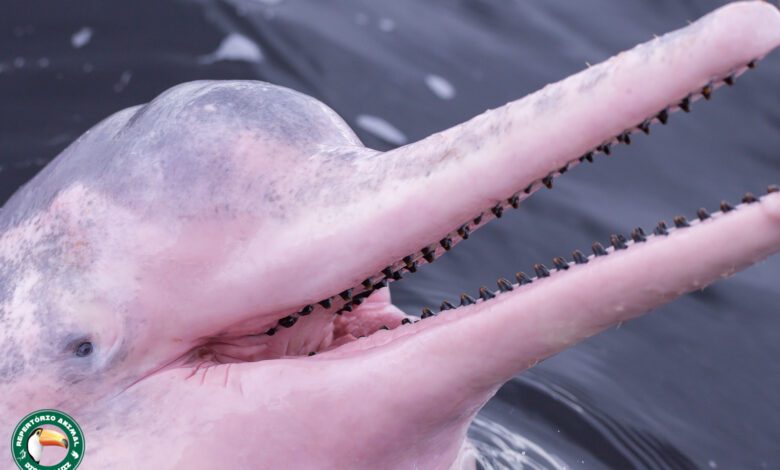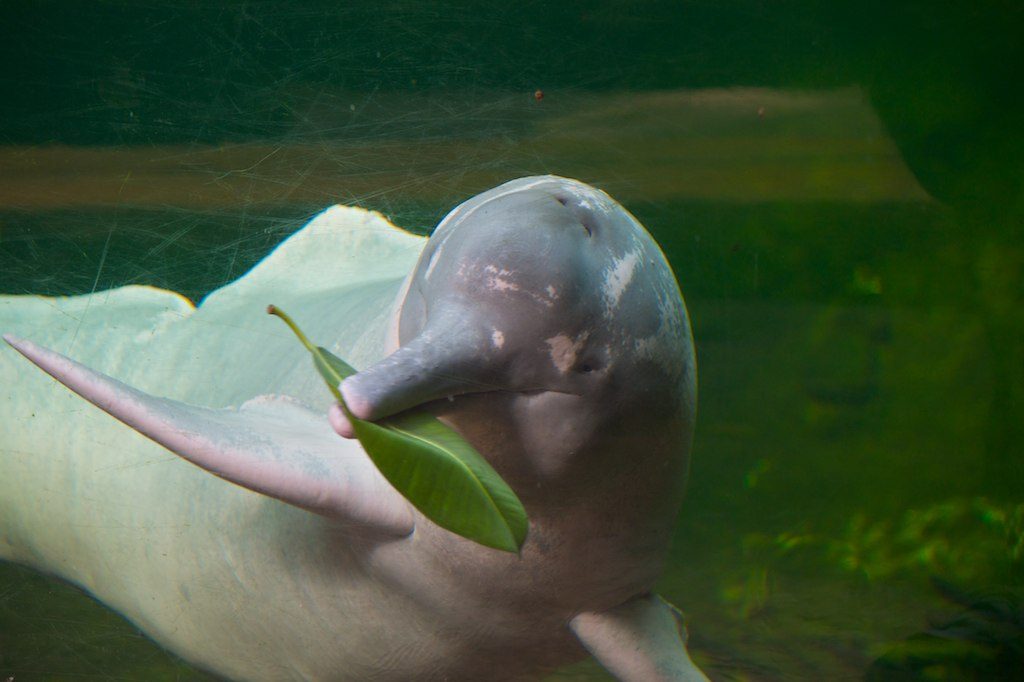Rare Aquatic Marvel: Say Hello to the Pink Dolphin

Inhabiting the vast Amazon River basin, the pink dolphin is a true symbol of the region’s incredible biodiversity. These remarkable creatures have evolved over millennia to thrive in the complex and ever-changing river systems, seamlessly blending into their watery domain. Their unique appearance and intriguing behaviors have long captivated the hearts and minds of local communities, as well as researchers and nature enthusiasts from around the globe.
Habitat and Distribution of Pink Dolphins
The natural habitat of the pink dolphin is primarily found in the Amazon River and its tributaries, spanning across several countries in South America, including Brazil, Colombia, Peru, and Venezuela. These dolphins have adapted to the diverse and dynamic river ecosystems, thriving in the deep channels, flooded forests, and even the estuarine regions where the river meets the sea.
The distribution of the pink dolphin is closely tied to the seasonal fluctuations of the Amazon River. During the dry season, when water levels are lower, the dolphins tend to congregate in the deeper, more permanent channels and lakes. As the rainy season arrives and the river expands, the dolphins disperse, taking advantage of the newly flooded forests and wetlands to forage and socialize.
Physical Characteristics and Unique Features of Pink Dolphins
One of the most captivating features of the pink dolphin is its vibrant, almost luminescent, pink coloration. This unique hue is believed to be the result of a specialized circulatory system that allows the dolphins to regulate their body temperature and blood flow. As they age, the dolphins’ skin can become increasingly pinkish, with the older individuals often displaying the most vivid and striking shades.
In addition to their mesmerizing color, pink dolphins possess several other distinctive physical characteristics. They have a robust, muscular build, with a rounded, blunt-shaped head and a long, slender beak-like snout. Their flippers and tails are broad and powerful, enabling them to effortlessly navigate the complex river systems. Interestingly, pink dolphins also have an extra vertebra in their necks, granting them greater flexibility and maneuverability in the water.
Also read: A Guide to the Majesty of Night-Blooming Jasmine
The Significance of Pink Dolphins in Folklore and Culture
The pink dolphin has long held a special place in the folklore and cultural traditions of the indigenous communities living along the Amazon River. These enigmatic creatures are often revered as spiritual beings, with many stories and legends surrounding their origins and behaviors.
In some cultures, the pink dolphin is often seen as a guardian of the river, with the belief that they possess the ability to both harm and heal those who encounter them. This reverence and respect for the dolphins has helped to foster a deep appreciation for their conservation among local communities, who play a vital role in protecting these remarkable creatures.
Threats and Conservation Efforts for Pink Dolphins
Despite their cultural significance and awe-inspiring beauty, the pink dolphin faces a number of threats to its continued survival. Habitat loss and degradation, due to factors such as deforestation, dam construction, and pollution, have had a significant impact on the species. Additionally, the dolphins are sometimes hunted for their meat or accidentally caught in fishing nets, further exacerbating their plight.
In response to these pressing challenges, various conservation organizations and government agencies have implemented a range of initiatives to protect the pink dolphin and its fragile ecosystem. These efforts include establishing protected areas, regulating fishing and development activities, and raising awareness about the importance of preserving this unique species.
One particularly promising approach is the promotion of ecotourism, which allows visitors to observe the pink dolphins in their natural habitat while generating much-needed revenue for local communities and conservation efforts. By fostering a deeper appreciation for the dolphins and their environment, ecotourism can play a crucial role in ensuring the long-term survival of this remarkable aquatic marvel.
Research and Scientific Studies on Pink Dolphins

The pink dolphin has long been the subject of intense scientific fascination and research, as scientists strive to unravel the mysteries surrounding this enigmatic creature. From studies examining the dolphins’ unique physiology and behavior to investigations into their role within the Amazon River ecosystem, the knowledge gained through these efforts has been invaluable in informing conservation strategies and deepening our understanding of this remarkable species.
One area of particular interest is the dolphins’ communication and social dynamics. Researchers have observed the intricate vocalizations and complex social interactions of the pink dolphins, shedding light on the rich tapestry of their lives and the vital role they play within their communities. Additionally, studies have explored the dolphins’ foraging habits, migration patterns, and adaptations to the ever-changing river environment, providing crucial insights that can guide conservation efforts.
As the scientific community continues to explore the secrets of the pink dolphin, new discoveries and breakthroughs are sure to emerge, further enhancing our appreciation for these captivating creatures and the importance of preserving their fragile habitats.
Ecotourism and Pink Dolphin Watching
The pink dolphin has become a major draw for ecotourism in the Amazon region, with countless visitors flocking to catch a glimpse of these remarkable creatures in their natural environment. Responsible and sustainable ecotourism initiatives have not only provided economic opportunities for local communities but have also played a vital role in raising awareness about the importance of conserving the pink dolphin and its fragile ecosystem.
During a pink dolphin watching excursion, you can expect to be awestruck by the graceful movements and captivating behaviors of these enigmatic creatures. As you glide silently along the river, you may witness the dolphins’ playful antics, such as breaching the water’s surface or engaging in social interactions with their pod mates. The opportunity to observe the pink dolphins in their natural habitat is a truly unforgettable experience, one that can foster a deep appreciation for the wonders of the natural world.
Moreover, the revenue generated through ecotourism has enabled local communities to invest in conservation efforts, funding crucial research, habitat restoration, and anti-poaching initiatives. By participating in responsible pink dolphin watching tours, you can contribute directly to the protection and preservation of this remarkable species, ensuring that future generations can marvel at their enigmatic beauty.
Pink Dolphins in Captivity
While the pink dolphin’s natural habitat is undoubtedly the best place to observe and appreciate these captivating creatures, some have been placed in captivity for various reasons, such as research or conservation efforts. However, the keeping of pink dolphins in captivity remains a highly controversial and complex issue, with ongoing debates surrounding the ethical and practical considerations.
One of the primary concerns with captive pink dolphins is the challenge of replicating the vast, dynamic river systems they have evolved to thrive in. The confinement of these intelligent and social animals can lead to stress, health issues, and the disruption of their natural behaviors. Additionally, the capture and removal of pink dolphins from their native habitats can have significant ecological consequences, potentially disrupting the delicate balance of the Amazon River ecosystem.
That being said, there are some instances where captive programs have played a role in conservation, such as the rehabilitation and release of injured or orphaned dolphins, or the use of captive individuals for research that informs wild population management. However, these efforts must be undertaken with the utmost care and consideration for the welfare of the animals involved.
As you ponder the complexities of pink dolphins in captivity, it’s important to recognize that the most meaningful and sustainable way to appreciate and protect these remarkable creatures is through the preservation of their natural habitats and the promotion of responsible ecotourism initiatives.
Myths and Misconceptions about Pink Dolphins
Despite the wealth of scientific knowledge and cultural reverence surrounding the pink dolphin, there are still numerous myths and misconceptions that persist in popular culture. These misunderstandings can often hinder conservation efforts and perpetuate harmful beliefs about the dolphins and their role within the Amazon River ecosystem.
One common myth is the idea that the pink dolphin is a supernatural or mythical creature, rather than a real, living animal. While the dolphins’ vibrant coloration and intriguing behaviors have undoubtedly contributed to their mythical status, it’s important to recognize that they are very much a part of the natural world, with their own unique evolutionary adaptations and ecological significance.
Another persistent misconception is the notion that pink dolphins are dangerous or aggressive towards humans. In reality, these dolphins are generally quite gentle and docile, and pose little threat to people. In fact, many local communities revere the pink dolphin as a benevolent, even protective, presence in the river.
By dispelling these myths and misconceptions, we can foster a deeper understanding and appreciation for the pink dolphin, ultimately strengthening the case for its conservation and ensuring that these remarkable creatures continue to thrive in their natural habitats.
Celebrating the Beauty and Protecting the Future of Pink Dolphins
As you’ve discovered, the pink dolphin is a true marvel of nature, a captivating creature that has captured the hearts and imaginations of people around the world. From its vibrant, almost ethereal coloration to its intricate social dynamics and cultural significance, the pink dolphin is a testament to the incredible diversity and resilience of life on our planet.
Yet, despite their enduring beauty and importance, the pink dolphin faces an uncertain future, threatened by a range of environmental challenges and human activities. It is our responsibility, as stewards of the natural world, to ensure that these remarkable creatures continue to thrive and that their fragile habitats are protected for generations to come.
By supporting conservation efforts, participating in responsible ecotourism, and sharing your knowledge and appreciation for the pink dolphin, you can play a vital role in safeguarding the future of this enigmatic aquatic marvel. Join us in our mission to celebrate the beauty and protect the legacy of the pink dolphin, ensuring that its captivating presence continues to inspire and awe all who encounter it.




